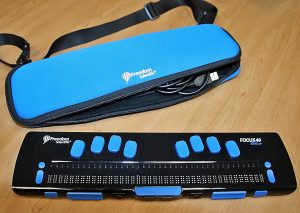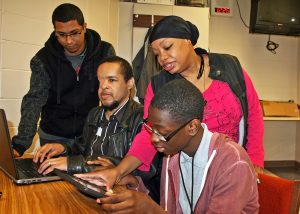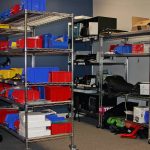
The Focus40 refreshable-display braille keyboard provides blind users full access to their computers.
As it approaches its 200-year anniversary, Braille continues to be a time-proven means of communication. Even more, with many recent innovations in assistive technology, Braille has become much more accessible. Of particular note are braille displays. These are assistive technology (AT) devices provide access to information on a computer screen. On top are 40 or more braille cells or characters; each one has the six dots, which the display raises and lowers to represent each letter of the alphabet and the numerals 1 through 0 (the last being combined with other numerals to create multiples of 10). Where they differ from braille on paper and other hard surfaces is that change (refresh) continuously as the user moves the cursor around on the screen though any input apparatus, including screen reader commands (e.g., JAWS).

Tyion L., a blind high school student, receives hands-on assistance from Paul Day, Assistive Technology Specialist. Also present is his high school aide.
It is worth noting the advantages of braille displays have over synthetic speech: they provide direct access to information; allow the user to check format, spacing, and spelling; and are quiet. The price of braille displays range from $3,500 to $15,000, depending on the number of characters displayed, usually 40, 70 or 80 characters. A 40-character display is sufficient for most jobs. That said, we’ll discuss the Focus 40 Blue, which has proven successful with several of our blind clients, such as Tyion L.
Focus 40 Blue
Freedom Scientific has recently rolled out its Fifth-Generation Focus refreshable braille display. This is an even more rugged version of the proven Focus 40 Blue. This device, as the name suggests, contains 40 braille cells, sufficient for most users. At the top are eight keys braille keys, which are used to enter commands. As with a conventional keyboard, the space bar is at the very bottom. Unique to Focus 40 Blue are NAV Rockers which, according to the manufacturer, allows the user to scroll by line, sentence, or paragraph, as well as pan through a document. The menu control well situated, located above the cursor router buttons. This design allows for quick access to the calendar and other Bluetooth connections. A feature called VariBraille enables the user to select the firmness of the braille cells. Furthermore, Focus 40 Blue is compatible with the extremely popular JAWS screen reader, which we covered in this space earlier, as well as OpenBook scanning and reading software.
The American Foundation for the Blind website lists this and additional braille displays, along with other braille AT products.
For New Jersey residents looking for more traditional books in braille, there is the Library Equal Access Program. LEAP is currently available seven libraries throughout the state. Having taken a look into the future today, on Thursday we’ll take a brief look back to the man who made reading and writing for the blind possible.

The Seeing Eye do is another way to provide access to the everyday to the blind.
braille assistive technology


